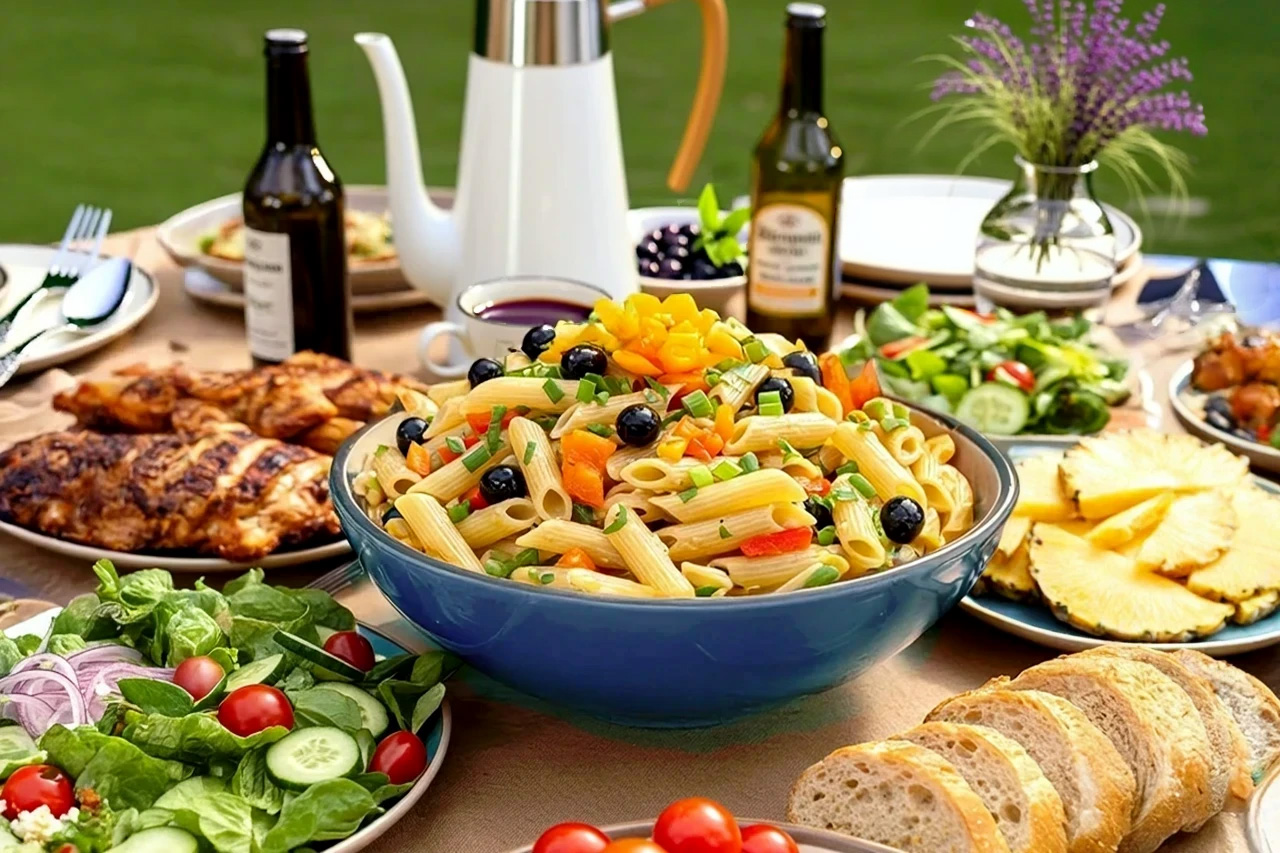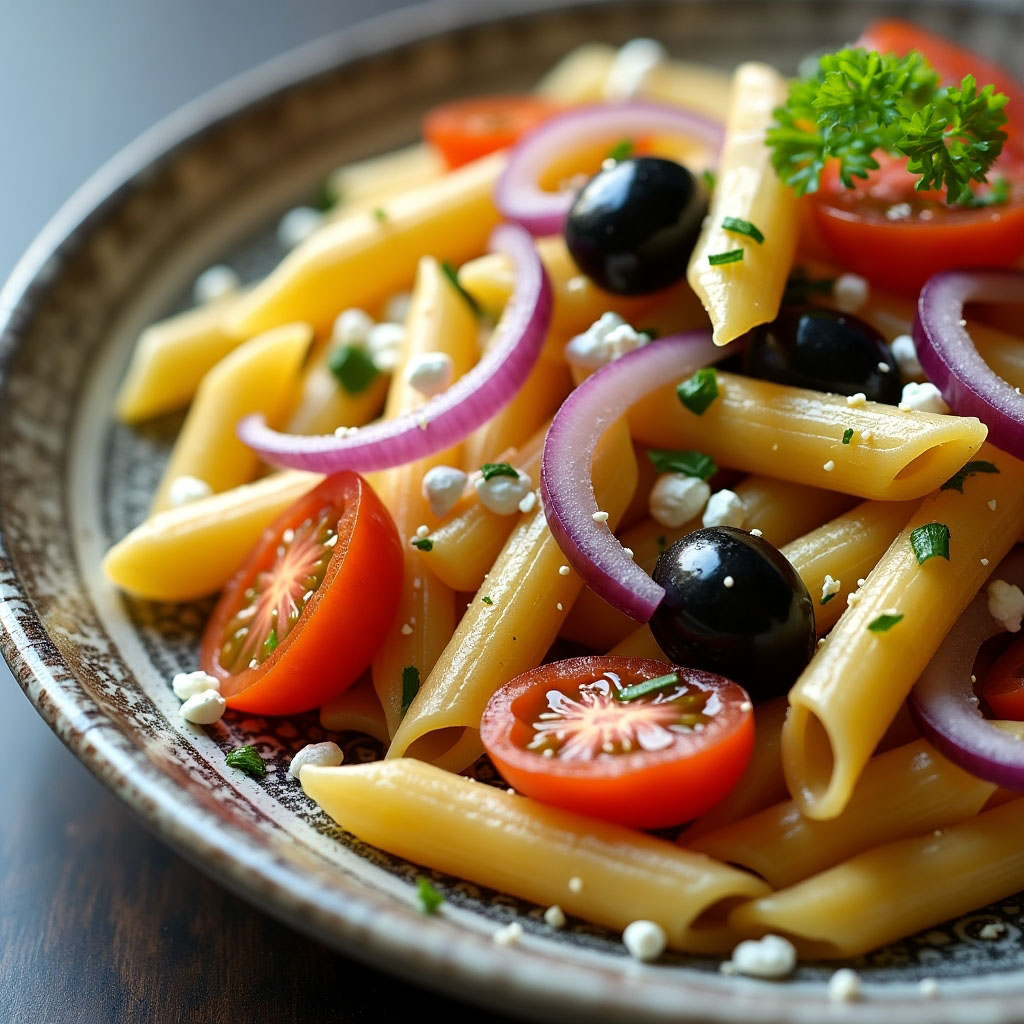Pasta Fresca
For a Surefire Potluck Dish that’s Fresh, Delicious, and Never a Regret
This vibrant pasta salad doesn’t cling to the past—it celebrates the present.
Light, zesty, and full of color, it’s worth every chop, stir, and sprinkle for a dish that travels well, disappears quickly, and is never, ever regrettable.
 Say hello to Dame Lucia Moretti, a woman who grew up where the lemons are sun-kissed, the tomatoes are rich with flavor, and the table is always set for one more guest. She’s the Dame who reminds us that the Mediterranean way of life isn’t just about what’s on your plate—it’s about savoring simple, vibrant ingredients and saying yes to meals that nourish the body and the spirit. Her recipe is a celebration of that: fresh, colorful, no regrets—just good company and even better living.
Say hello to Dame Lucia Moretti, a woman who grew up where the lemons are sun-kissed, the tomatoes are rich with flavor, and the table is always set for one more guest. She’s the Dame who reminds us that the Mediterranean way of life isn’t just about what’s on your plate—it’s about savoring simple, vibrant ingredients and saying yes to meals that nourish the body and the spirit. Her recipe is a celebration of that: fresh, colorful, no regrets—just good company and even better living.
“First we eat, then we do everything else.”
— Mary Frances Kennedy Fisher, An Alphabet for Gourmets (1949)
Prep Time
25 minutes
Cook Time
10 minutes (for pasta + toasting pine nuts)
Total Time
35 minutes
Serving
8-10 side servings
Ingredients
PASTA
- 1 pound mostaccioli (or penne) noodles
- 4 ounces crumbled feta cheese, divided
- 1 dozen cherry tomatoes (halved)
- ¼ cup sliced Greek Kalamata olives
- 4 green onions, diced
- ½ cup pine nuts, divided (sauteed in 2 teaspoons olive oil)
- ½ cup orange, yellow or red pepper, diced
DRESSING
- ¼ cup red wine vinegar
- 3 tablespoons seasoned rice vinegar
- ½ cup of extra virgin olive oil
- 2 tablespoons fresh parsley
- ½ teaspoon dried mustard
- ½ teaspoon garlic salt

Preparation
- Cook pasta, al dente, cool.
- In a large bowl, combine pasta, tomatoes, peppers, olives, green onions, 2 ounces of feta cheese and 2 ounces of sauteed pinenuts.
- In a separate bowl, blend dressing ingredients well with wire whisk. Taste test to adjust with more seasoned red vinegar for tanginess.
- Pour over salad, mix well.
- Add remaining feta cheese and pine nuts on top. Chill. Mix again prior to serving.
Yield: 8-10 servings.
Pair with Tea & Trivia
Getting a Handle on Tea
THE “HANDLELESS” JAPANESE TEACUP
To Westerners, teacups without handles seemed like a design flaw—where would one’s dainty pinky go? But in Japan, the lack of a handle was intentional: the cup’s heat tells the drinker whether the tea is still too hot to sip. Originally thought by European traders to be an oversight or even a manufacturing error, these yunomi cups turned out to be a brilliant lesson in mindfulness—inviting you to slow down and connect with your senses.
TEA AS COMFORT, CLOSURE & CLEVER MISTAKES
Tea has long been a remedy for reflection, a comfort for closure, and proof that even mistakes can be steeped into something brilliant.
THE LITERARY STEEP: LESSONS IN LETTING GO
In Eat a Bowl of Tea by Louis Chu, bitter tea becomes a metaphor for facing hardship head-on. It’s not about denying the past—it’s about digesting it, learning from it, and moving forward with a cleansed spirit.
MISTAKES THAT MADE HISTORY
In 1908, New York tea merchant Thomas Sullivan sent out silk pouches of tea samples. Customers plunked the whole sachet into hot water—and accidentally invented the tea bag. Proof that not all mistakes lead to regret—some can even launch a revolution.
TRIVIA SIP: The Fortune-Telling Teacup – Did you know that, in the 17th and 18th centuries, leftover tea leaves at the bottom of the cup were considered unsightly—or a sign of poor brewing technique? In Romani and Scottish traditions, these remnants became the foundation of Tasseography, or tea leaf reading. Suddenly, what had been a mistake was seen as a glimpse into fate, love, or the next big decision.

BLUEBERRY DELIGHT
An organic herbal blend of hibiscus, elderberries, currants, and blueberries with cornflower petals—sweet, soothing, and vibrant. The kind of tea that says, “You’ve grown. You’re glowing. Now serve up something festive.”


